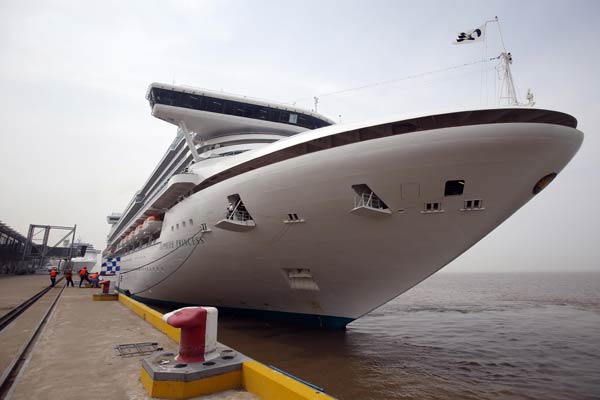Full steam ahead for cruise industry
China Daily, December 25, 2014 Adjust font size:

The Carnival cruise ship Princess Cruises arrives in Shanghai, May 21, 2014. [China Daily]
With the government keen on making China the largest cruise market in the Asia-Pacific region by 2020, the cruising industry seems to have got the much-needed impetus for rapid development, judging by the frenzy of activity within the sector.
Evidence that the sector is rapidly unfurling its sails can be gauged from the growth in the number of cruises from China. According to the 2014 China Cruise Industry Development Report released by the China Cruise and Yacht Industry Association on Wednesday, the total number of cruises from China is expected to be around 466 by the end of 2014, a 14.78 percent year-on-year growth.
Breaking this down further, one can see that these trips involved about 860,000 tourists, a 43.36 percent year-on-year growth. Of these tourists, about 739,600 were Chinese travelers who boarded the cruises from Chinese ports.
The Shanghai Port International Cruise Terminal received 576,000 tourists in 2014, and also zoomed past Singapore as the largest cruise terminal in Asia this year. Unlike most of the other sectors, the cruise industry has seen steady growth during the past eight years. That momentum is set to continue in 2015, said industry sources.
The China Cruise and Yacht Industry Association expects the number of cruises that will originate from Chinese ports to reach 12 next year, compared with eight cruises now. The number of Chinese mainland tourists taking cruises will cross 1 million for the first time in 2015.
The market size of the cruise industry, especially the number of tourists taking cruises, will continue to grow by at least 30 percent in 2015.
"We will see more itineraries introduced into the Chinese market in the next few months. The Chinese cruise sector will move up the industry chain with more companies taking part in shipbuilding, which will really inject more vitality into the economy," said Cheng Juehao, deputy director of the Shanghai International Shipping Institute's Cruising and Boating Research Center.
Zheng Weihang, executive vice-president of the China Cruise and Yacht Industry Association, said the rapid development has also led to the flow of more capital into the sector, throughout the industry chain.
"Some companies have shown interest in building cruise liners in Europe, which will be later handed over to domestic companies for operation. Some companies would like to go to the downstream of the industry chain to focus on travel agencies," said Zheng, adding that there is no need to be hasty, and it will take five years before the industry becomes more rational.
Despite the progress made in the past few years, there are still some problems that need to be addressed.
For one thing, the itineraries available now are quite limited, with most of the four- to five-day trips focusing on visits to Japan or South Korea. This will largely affect repeat trips for tourists who are interested in cruises, said Huang Ruiling, general manager of Costa Cruises Shipping Services (Shanghai) Co Ltd.
"The cruise industry chain in China is quite incomplete. We are now still unable to develop our own cruises, with European companies dominating this part of the market. Most of the leading companies are reputed global names, while the Chinese companies are those that have just started operations," said Xiao Baojia, director of the Cruising and Boating Research Center.
"Most of the Chinese ports focus more on appearance, rather than function. There is also a severe shortage of professional services in the cruise industry. Raw material supplies and government support are also not enough. But the real concern is obviously the shortage of high-end cruise industry talent," said Xiao.

